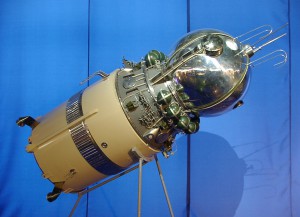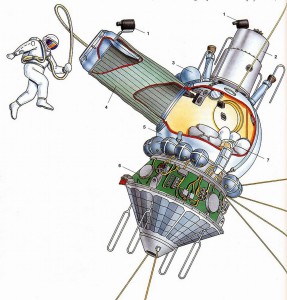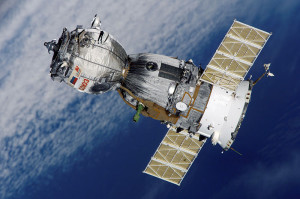Vostok
The Vostok (Russian: Восток, translated as East) was a type of spacecraft built by the Soviet Union. The first human spaceflight in history was accomplished on this spacecraft on April 12, 1961, by Soviet cosmonaut Yuri Gagarin.
The spacecraft was part of the Vostok programme in which six manned spaceflights were made from 1961 to 1963. Two further manned space flights were made in 1964 and 1965 by Voskhod spacecraft, which were modified Vostok spacecraft. By the late 1960s both were superseded by the Soyuz spacecraft, which are still used as of 2014.
Voskhod
The Voskhod (Russian: Восход, „Sunrise“) was a spacecraft built by the Soviet Union‘s space program for human spaceflight as part of the Voskhod programme. It was a development of and a follow-on to the Vostok spacecraft. Voskhod 1 was used for a three manned flight whereas Voskhod 2 had a crew of two. They consisted of a spherical descent module (diameter 2.3 meters), which housed the cosmonauts, and instruments, and a conical equipment module (mass 2.27 tonnes, 2.25 m long, 2.43 m wide), which contained propellant and the engine system. Voskhod was superseded by the Soyuz spacecraft in 1967.
Soyuz
Soyuz (Russian: Сою́з Ukrainian: Союз, IPA: [sɐˈjus]), Union) is a series of spacecraft designed for the Soviet space programme by the Korolyov Design Bureau in the 1960s that remains in service today. The Soyuz succeeded the Voskhod spacecraft and was originally built as part of the Soviet Manned Lunar programme.
The Soyuz spacecraft is launched on a Soyuz rocket, the most frequently used and most reliable launch vehicle in the world to date.[1][2] The Soyuz rocket design is based on the Vostok launcher, which in turn was based on the 8K74 or R-7A Semyorka, a Soviet  intercontinental ballistic missile. All Soyuz spacecraft are launched from the Baikonur Cosmodrome in Kazakhstan.
intercontinental ballistic missile. All Soyuz spacecraft are launched from the Baikonur Cosmodrome in Kazakhstan.
The first Soyuz flight was unmanned and started on November 28, 1966. The first mission with a crew, Soyuz 1, launched on 23 April 1967 but ended with a crash due to a parachute failure, killing cosmonaut Vladimir Komarov. The following flight was unmanned. Soyuz 3, launched on October 26, 1968, became the program’s first successful manned mission. The only other flight to suffer a fatal accident, Soyuz 11, killed its crew of three during re-entry when the cabin depressurized prematurely. Despite these early incidents, Soyuz is widely considered the world’s safest, most cost-effective human spaceflight system,[3] established by its unparalleled length of operational history.
Soyuz spacecraft were used to carry cosmonauts to and from Salyut and later Mir Soviet space stations, and are now used for transport to and from the International Space Station (ISS). At least one Soyuz spacecraft is docked to ISS at all times for use as an escape craft in the event of an emergency.
The Soyuz spacecraft is intended to be replaced by the six-person Prospective Piloted Transport System.


